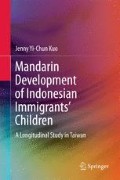Abstract
The results of the present study show that the Mandarin phonological development by the children of immigrant mothers might be influenced by their mothers’ Mandarin (L2) because they made similar errors. Since the same errors were observed among children of mothers of different nationalities, they cannot be attributed to the mothers’ L1 alone. Despite the similar exposure to Taiwan Mandarin as native children, children of immigrants made unique errors. This indicates the importance of primary interlocutors, their mothers. Children of immigrants have received input mediated through universal constraints, whose rankings are dynamic in the process of development. Innatism and interactionism may not be mutually exclusive as the proposal for ‘innately guided learning’ (Gould and Marler 1987; Jusczyk and Bertoncini in Learn Speech 31:217–238, 1988; Marler in The Epigenesist of mind: Essays on biology and cognition. Lawrence Erlbaum Associates, Hillsdale, 1991).
Access this chapter
Tax calculation will be finalised at checkout
Purchases are for personal use only
References
Bernstein Rater, N. (1984). Patterns of vowel modification in mother-child speech. Journal of Child Language, 11, 557–578.
Boersma, P., & Hayes, B. (1999). Empirical tests of the gradual learning algorithm. ROA-348.
Cheng, C. C. (1973). A synchronic phonology of Mandarin Chinese, monographs on linguistic analysis 4. The Hague: Mouton.
Cheng, R. L. (1997). Taiwanese and Mandarin structures and their developmental trends in Taiwan I: Taiwanese phonology and morphology. Taiwan: Yuan-Liou Publishing Co. Ltd.
Dekkers, J., Leeuw, F., & Weijer, J. (Eds.). (2000). Optimality theory: phonology, syntax, and acquisition. Oxford: Oxford University Press.
Duanmu, S. (2000). The phonology of standard Chinese. New York: Oxford University Press.
Gleason, J. B. (2012). The development of language (8th ed.). Boston: Pearson.
Gnanadesikan, A. E. (1996). Child phonology in optimality theory: Ranking markedness and faithfulness constraints. In Proceedings of the 20th Annual Boston University Conference on Language Development (Vol. 1, pp. 237–248).
Gould, J. L., & Marler, P. (1987). Learning by instinct. Scientific American, 225(1), 75–85.
Hsu, J. (1996). A study of the stages of development and acquisition of Mandarin Chinese by children in Taiwan. Taipei: Crane.
Huang, L. (2011). Mandarin consonant acquisition of children of Vietnamese and Indonesian Mothers in Taiwan (M.A. thesis). Chiayi: National Chiayi University.
Jusczyk, P. W., & Bertoncini, J. (1988). Viewing the development of speech perception as innately guided learning process. Learning and Speech, 31(3), 217–238.
Kager, R. (1999). Optimality theory. Cambridge: Cambridge University Press.
Kuo, J. Y. (2008). Mandarin acquisition by children of Vietnamese mothers in Taiwan. Taipei: Crane.
Ladefoged, P., & Johnson, K. (2015). A course in phonetics (7th ed.). Independence: Cengage Learning.
Li, Y. J. (2006). A study of the segments in hearing-impaired preschoolers’ learning of Mandarin Chinese (Unpublished M.A. thesis). Providence University.
Liu, H. C. (1999). An optimality-theoretic analysis of Taiwanese consonant acquisition (Unpublished M.A. thesis). National Chung Cheng University.
Liu, H. C. (2009). Speech errors in Taiwan Southern Min: A phonological study (Ph.D. Thesis). National Tsing Hua University.
Macdonald, R. R., & Darjowidjojo, S. (2007). Indonesian reference grammar. Georgetown: University Press.
Malsheen, B. (1980). Two hypotheses for phonetic clarification in the speech of mothers to children. In G. Yeni-Komshian, J. F. Kavanagh & C. A. Ferguson (Eds.), Child phonology: Vol. 2. Perception. New York: Academic Press.
Marler, P. (1991). The instinct to learn. In S. Carey & R. Gelman (Eds.), The Epigenesist of mind: Essays on biology and cognition. Hillsdale, NJ: Lawrence Erlbaum Associates.
McCarthy, J. (2008). Doing optimality theory: Applying theory to data. Hoboken: Blackwell Publishing.
McCarthy, J., & Prince, A. (1994). The emergence of the unmarked: Optimality in prosodic morphology. In Proceedings of the North East Linguistic Society (Vol. 24, pp. 333–379). Amherst (Mass.): GLSA. ROA-013
Menn, L. (1971). Phonotactic rules in beginning speech. Lingua, 26, 225–241.
Prince, A., & Smolensky, P. (1997). Optimality: From neutral networks to universal grammar. Science, 275, 1604–1610.
Prince, A., & Smolensky, P. (2004). Optimality theory: Constrain interaction in generative grammar. Malden: Blackwell.
Rau, D. H., & Li, M, C. (1994). Phonological variation of /tʂ/, /tʂh/, /ʂ/ in Mandarin Chinese. In Proceeding of the Fourth International Conference on Chinese teaching Pedagogy, Taiwan (pp. 345–361). Taipei: World Chinese Language Association.
Tesar, B., & Smolensky, P. (2000). Learnability in optimality theory. Cambridge, MA: The MIT Press.
Velleman, S. (1988). The role of linguistic perception in later phonological development. Journal of Applied Psycholinguistics, 9, 221–236.
Vietnamese language. (2007, September 28). Wikipedia, the free encyclopedia. Retrieved September 28, 2007 from http://en.wikipedia.ord/w/index.php
Chinese
Chung, Rong Fu. 鐘榮富. (2002).台語的語音基礎 “Taiyu de Yuyin Jichu” (The nature of Taiwanese). Taipei: The Crane Publishing Company.
Lin, Ling-Ying. 林玲英. (2005). 越籍配偶漢語語音偏誤現象初探 “Yueji peiou hanyu yuyin pianwu xianxiang chutan” (The study of Vietnamese foreign spouses’ phonetic errors in learning Mandarin Chinese). National Conference on Linguistics. Hsinchu: National Chiao-Tung University.
Author information
Authors and Affiliations
Corresponding author
Rights and permissions
Copyright information
© 2016 Springer Science+Business Media Singapore
About this chapter
Cite this chapter
Kuo, J.YC. (2016). Phonological Development. In: Mandarin Development of Indonesian Immigrants’ Children. Springer, Singapore. https://doi.org/10.1007/978-981-10-1035-4_2
Download citation
DOI: https://doi.org/10.1007/978-981-10-1035-4_2
Published:
Publisher Name: Springer, Singapore
Print ISBN: 978-981-10-1033-0
Online ISBN: 978-981-10-1035-4
eBook Packages: Social SciencesSocial Sciences (R0)

